Manou Marzban – An Artist for Our Times
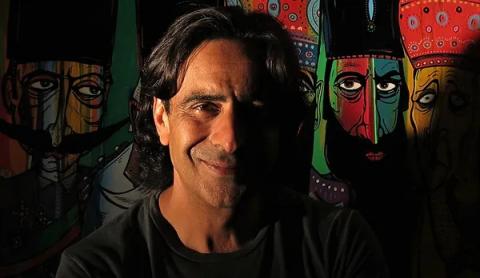
Every once in a while, someone arrives on the scene whose art and message become even larger than the individual himself. The Swiss-born Iranian-American artist Manou Marzban is just such a man.
Born in Switzerland in 1962 to a diplomat father, he was exposed at an early age to a diversity of people and cultures, giving him an invaluable global perspective. His expositions have drawn art enthusiasts in Berlin, Cannes, Nice, Paris, Monte Carlo, Baltimore, Geneva, Stockholm and London. He has said he just wants to “entertain.”
But this lighthearted genius of pop culture wants to make people think as well. Every icon from our combined histories is fair game for deconstruction, from colorfully painted World War II Nazi helmets—“just a piece of metal”—to cartoon renderings of historical figures from the Qajar dynasty.

Marzban’s vivid imagination holds supreme sway over every endeavor. He has said that if he analyzes an undertaking, he would never finish it.
Marzban believes that the ”nationalists” are a dying breed. In a hundred years, travel and communications worldwide will bring the human race closer together. The next generation will have far more understanding and compassion for one another. His mantra is “to live and let live, treat the world better, and challenge evil.”
With chaos, complexities, and challenges facing an uncertain world, Manou Marzban sounds like the King Arthur of our times.
Below is an interview Marzban recently conducted with Highbrow Magazine, discussing his perspective as an artist and his inspirations and philosophies.
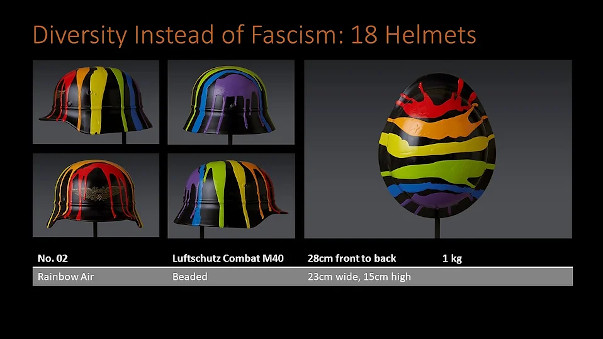
Highbrow Magazine: You have said that in a hundred years, diversity is inevitable. Given the increasing rise of nationalism around the world, and growing racism, do you see political revolutions and upheavals more imminent in the future?
Manou: Diversity is certainly inevitable. Why? One hundred years ago, very few people travelled, let alone got on an airplane. Today it is normal. In another hundred years, this exponential increase in travel, exposure, and communications will only grow, and slowly allow people to shed their xenophobic tendencies.
When people get to mix and understand each other on a human level...they tend to stop agitations. What we see today are the last kicks of a dying breed. The “nationalist.” And this breed exists in every country, every continent. Trump, Brexit, Putin are all results of this symptom. So yes, there will be upheavals. My message is to keep repeating “never again.” Conflicts can quickly take global dimensions. We don’t want that. History can repeat itself.
Of course, the concept of diversity can polarize people, especially those who feel marginalized . The media has become an agitator, waving the flames of extreme thinking, both on the right and the left. We have Nazis walking around again on the right, openly, and “woke” thinking has now gone beyond rationality on the left. Ultimately, our hope is in the next generations, who will have grown up in a global and digital world -- and have far more understanding and compassion for one another than my generation did.

Highbrow Magazine: Your art provokes and delights. As an artist, do you think that deconstructing iconic objects, like the SS helmets in your 'Diversity Instead of Fascism' exhibition, can inspire your audience to take to the streets to make real change in their political climate? Can art do that?
Manou: The first thing to do is to de-mask certain iconic objects, especially those that evoked fear, and see them for what they truly are. Once you understand that, it can help inspire new thinking. The German war helmets evoked such fear. Just the sight of them brought terror to millions. Now, that is insanely powerful symbolism. My thinking was simple: I will take this fearful symbol and cover it with messages that are in direct conflict to what it symbolizes. And that will dilute the message. What you are left with is just a helmet. Just a piece of metal. And perhaps that can inspire an audience to see the helmets of oppressive riot police and uniformed militias in the same light. Just a piece of metal. Nothing to fear.
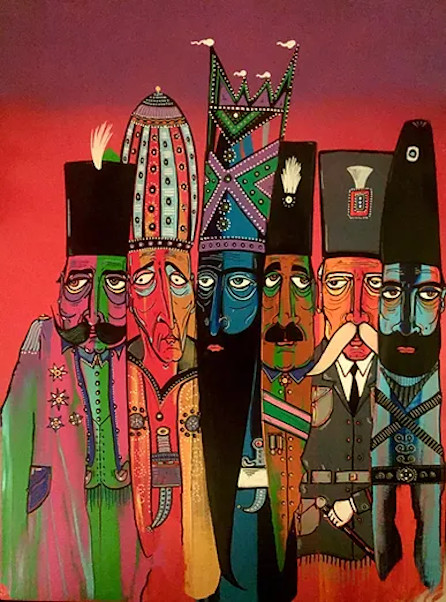
Highbrow Magazine: Will the current political climate continue to be your primary focus, or do you see your art as more transformational, evolving and changing in tune with your own artistic ambitions?
Manou: My art was never meant to be political. In fact, it’s been called “whimsical,” “fun,” but “thought-provoking.” I try to create a narrative in my pop art. I try to mix historical icons, political reflections, and popular culture all in one go. My desire is to entertain you. To make you think and ask questions. My Persian Qajar Streak series is playful. They are caricatures in bright colors, not the usual dour visions we see of classic Persian kings. My art features many mixtures of styles. Always transforming. From installations to videos. I will always try to evolve. As an artist, you can get recognition for just one particular form of creation...that boxes you in. But hey, we need to pay the bills too! So you do what you know sells. The key is to keep experimenting. Keep pushing your creative energy.
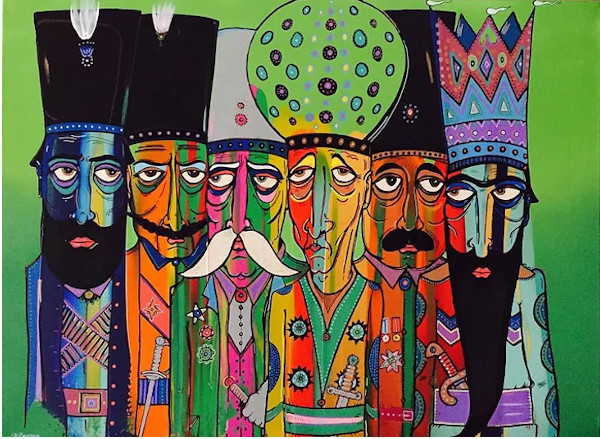
Highbrow Magazine: You are a Swiss-born, Iranian-American artist and the son of a diplomat. How has your international outlook shaped your art?
Manou: My very diverse personal background laid the foundation for my art. As a child, in various destinations, I tuned into American Forces TV. That meant early exposure to classic films of the 40s, 50s, as well as TV shows and cartoons from the 60s and 70s. I grew up with comic books and graphic novels like Tintin and Asterix. I attended a British boarding school in the 70s, where hours of boredom meant having to ignite an active imagination. All that travel and international exposure meant no real roots but an amazing [exposure] at an early age to diverse people and cultures. My art tries to touch on these childhood experiences via cultural and historical references. And I guess that gives my art an international appeal. I certainly felt that, having done expos in many capitals across Europe.
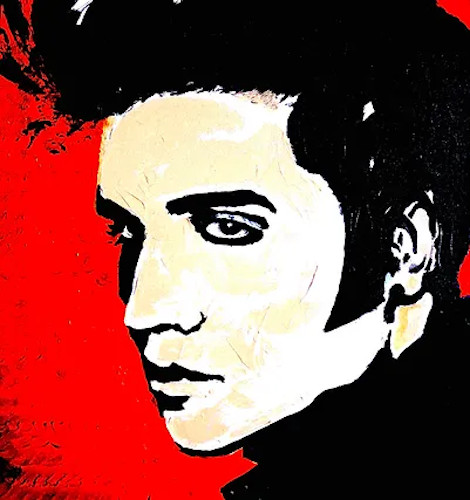
Highbrow Magazine: How did the Iranian revolution of 1979 shape your perspective as an artist?
Manou: Prior to the revolution, I studied art like everyone else in school. I got my GSCEs and ‘A’ level art degrees earlier than most, and took my creativity for granted. Indeed, in boarding school, my doodles of teachers and students kept my classmates amused for hours. I had returned to Iran in 1977 – and loved it. But soon, the country was gripped in turmoil.
When I was in Iran, an art teacher at the international school, Mr Minton, encouraged me to study art, because I was a “natural”: I could simply draw, like some can create music, effortlessly. I only fully realized that my creative talent is perhaps more than just making my friends giggle after I arrived in Washington DC in January 1979.
In Washington, I declared to my father my intention to study art. That didn’t go down well. In fact, it didn’t go anywhere. Instead, I studied Communication and eventually, as the oldest son of a VIP father, I studied Business and entered the workforce....art was shelved. I believed that with the Iran-Iraq war, the desperate Persian diaspora trying to fit in anywhere they can outside of Iran, and the sheer uncertainty that naturally follows any revolution – how could I study art? I became a yuppie in the tech world.
My father passed away in 2004. I started really exploring my creativity in 2009. By 2010, I had my first event, and by 2017, I had made an impact – especially with the Persian audience. My expos are usually entertaining events, not your classic art shows. I like to make people feel like they have attended a party. Maybe that’s a throwback to seeing my diplomat parents entertain almost nightly when I was a kid.
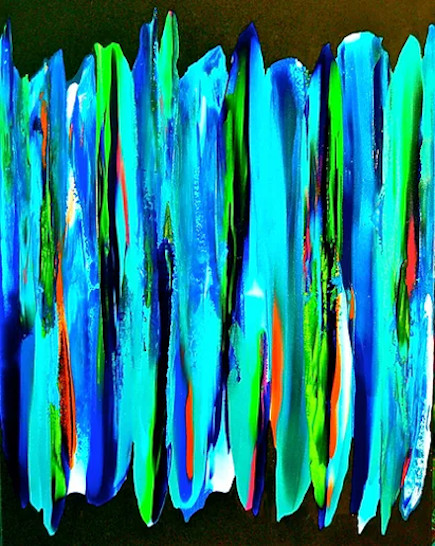
Highbrow Magazine: Who are some of your favorite artists?
Manou: This is a question I am often asked in interviews, which always makes me smile because I have no profound or impressive answers. Like many, I like Dali, Picasso, Warhol, Miro...who doesn’t?
But then, I am inspired by Sergio Argones, a MAD Magazine cartoonist. I never studied art or art techniques; I am 100 percent self-taught. Trial and error. I like so many different kinds of art, that it is impossible for me to say what or who is my favorite.
I am influenced by film, TV, actors....I also have a degree in Film History from American University in Washington DC. I think film has influenced me more than anything. But I don’t have a favorite film. Too many great ones. An image is an image, a film is many images.
Having said all this, if there is one school of art I will subscribe to, it is the “enigmatism” approach. That is: plan nothing, let the creativity pour out, and discover the beauty of the unexpected. It’s all about storytelling, and emotional transfer. That, in essence, is the core of my art. My ‘Streaks’ series is exactly that. So, if there is one person I can tell you I find enthralling, it is the French artist Gérard Salomon.

Highbrow Magazine: You have been compared to Banksy. What are your thoughts on this comparison?
Manou: That is stretching it! I must say I was a bit surprised when that happened. First, I don’t paint on walls; secondly, I am not shrouded in mystery. Google knows where I am. But nonetheless, I am of course honored. I guess the reason was more [because] of the messages we both try to convey -- that is, to live and let live, treat people equally, treat the world better, and always challenge evil. We are at a historical crossroads now: We can put our lot with the people on this planet who want to heal and mean well, or fall on the side of skullduggery. I have hope for sure -- hope in our children and their children.
For more information about the artist, visit: Manou Art.
Author Bio:
Sandra Bertrand is Highbrow Magazine’s chief art critic.
For Highbrow Magazine
--All images are courtesy of the artist.































































































































































































































































































































